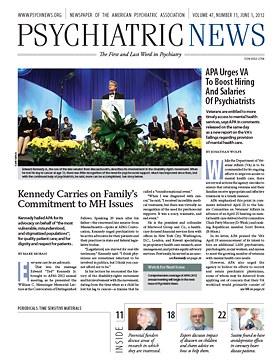The late experimental psychologist Karl Lashley, Ph.D., spent three decades sectioning the brains of rats and mice, hoping to find the “engram,” the physical evidence of memory, only to conclude that memory was distributed throughout the cortex.
Yet more recent work finds that single, specific neurons in the human hippocampus are indeed part of a memory trace, said Sheena Josselyn, Ph.D., a senior scientist in neurosciences and mental health at the Hospital for Sick Children in Toronto and an associate professor of physiology at the University of Toronto.
Josselyn spoke at the 7th Annual Conference on the Amygdala, Stress, and Posttraumatic Stress Disorder (PTSD), held at the Uniformed Services University of the Health Sciences in Bethesda, Md., in April.
She noted a 2008 report by Hagar Gelbard-Sagiv, Ph.D., now a postdoctoral fellow in biology at the California Institute of Technology, on “the activity of single neurons in the human hippocampus and surrounding areas when subjects first view cinematic episodes consisting of audiovisual sequences and again later when they freely recall these episodes.”
Among the test sequences was the often-shown clip of Tom Cruise jumping up and down on Oprah Winfrey’s couch.
“That single neuron fired only when viewing the Tom Cruise video or when remembering it, but not at other times,” said Josselyn.
Josselyn uses classic auditory fear conditioning in mice to study memory neuron by neuron in the lateral nucleus of the amygdala. The transcription factor CREB preferentially activates neurons there in the encoding of fear memories. Neurons with high levels of CREB are preferentially incorporated into the fear memory trace, while decreased CREB levels are actively excluded from memory function, she said.
Infusing CREB with a modified viral vector into CREB-knockout mice rescued the memory deficit by recruiting neurons to the memory trace.
Next she used diphtheria toxin to kill only the cells previously infected with the viral CREB.
“The diphtheria toxin blocks the enhancement of memory,” said Josselyn. “The effects are robust, specific to cells with high levels of CREB, and persisted for up to 10 days. The effects were not due to disruption of reconsolidation or to overall disruption of lateral amygdala function.”
The animal can still form new memories with retraining and deleting neurons with the CREB vector before training does not impair memory, she said. Neurons in the lateral amygdala with increased CREB competitively advantage memory, and killing them is sufficient to induce memory loss.
Thus, those neurons constitute a critical component of the neuronal network required for the subsequent expression of that memory, she explained.
However, killing neurons to eliminate memories was an extreme step, so Josselyn sought to block the action of the affected cells in some less drastic way.
One solution was using tetanus toxin to prevent activity-dependent release of neurotransmitters at the cell terminal.
“That simply cuts off communication with a cell infected by CREB,” she said. “The cell can receive input and fire, but it cannot communicate with the next cell in line. The fear memory is never expressed.”
Ultimately, work like that from Josselyn’s lab may improve understanding of the mechanisms of memory and lead to new ways of treating anxiety and learning-based disorders in humans.

